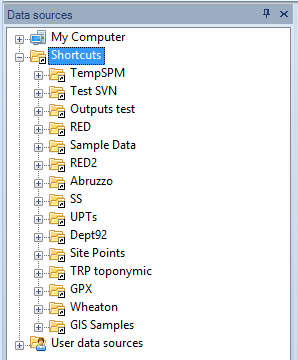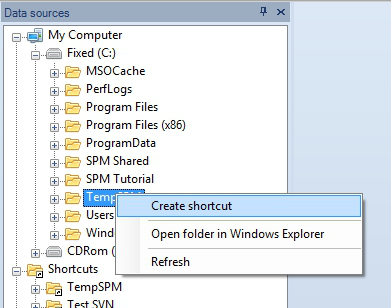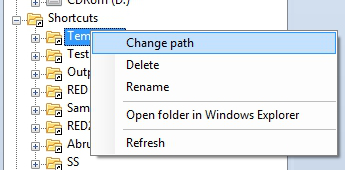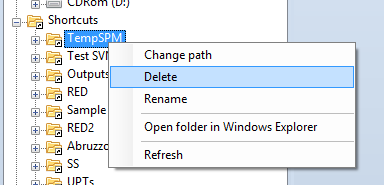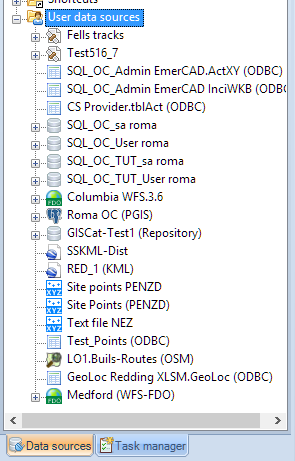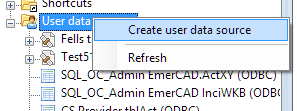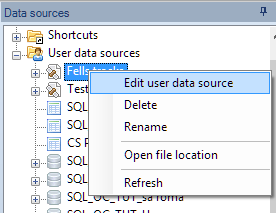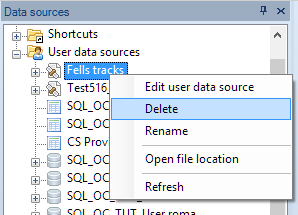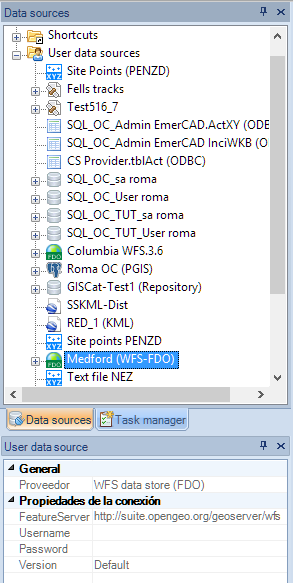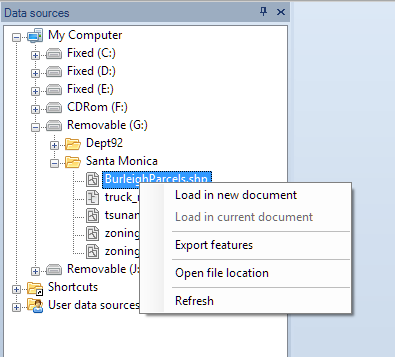Difference between revisions of "Spatial Manager Desktop™ - FAQs: Data sources"
m |
m |
||
| Line 63: | Line 63: | ||
| − | When you create a new UDS to connect with a particular spatial database server, you need to choose the appropriate Provider for this server, the connection parameters for the server and the name of the UDS. When you create a UDS to access a particular spatial data file, you need to also choose the appropriate Provider for this file, the file itself, the file parameters and the name of the UDS. All this data is saved, into your application configuration, until you want delete it or modify it. Note that if you choose a read-only Provider you will be able to read data through this UDS but not to write data | + | When you create a new UDS to connect with a particular spatial database server, you need to choose the appropriate data Provider for this server, the connection parameters for the server and the name of the UDS. When you create a UDS to access a particular spatial data file, you need to also choose the appropriate data Provider for this file, the file itself, the file parameters and the name of the UDS. All this data is saved, into your application configuration, until you want delete it or modify it. Note that if you choose a read-only data Provider you will be able to read data through this UDS but not to write data |
| Line 97: | Line 97: | ||
===How can I recognize each different type of spatial data and its Properties in Spatial Manager Desktop™?=== | ===How can I recognize each different type of spatial data and its Properties in Spatial Manager Desktop™?=== | ||
| − | To recognize each different type of spatial data, you will see the different icons used for each Provider in the "Data sources" panel of Spatial Manager Desktop™. In addition, when you select any data source you will see its Properties in the "Properties" panel | + | To recognize each different type of spatial data, you will see the different icons used for each data Provider in the "Data sources" panel of Spatial Manager Desktop™. In addition, when you select any data source you will see its Properties in the "Properties" panel |
Revision as of 00:36, 14 February 2014
Introduction
- Objective of this section
- To become familiar with the different methods defined in Spatial Manager Desktop™ to access spatial data
- Topics in this section
- Disk drives (files): disk drives or local and network folders
- Shortcuts (files): definition and edition of access to folders
- User data sources (UDS - files or databases): definition and edition of UDSs
- Data sources properties: differential icons and properties
What are the Shortcuts in Spatial Manager Desktop™?
The Shortcuts are the way you can reference any folder into a physical or net drive, or the drive itself, and allows you quick access to its path. You can access the Shortcuts through the "Data sources" panel
How can I create a new Shortcut in Spatial Manager Desktop™?
You can create new Shortcuts using the right-click menu over the "Shortcuts" paragraph, in the "Data sources" panel, and choosing a folder or drive. You can also create a new Shortcut using the right-click menu over any folder or drive item that you can see in the "Data sources" panel, to reference the path of this folder or drive
How can I edit a Shortcut in Spatial Manager Desktop™?
You can edit a Shortcut using the right-click menu over the item, in the "Data sources" panel, to change the path of the folder or drive referenced. You will see a Warning window if the Shortcut is referenced by any Task
Are there any other functions for the Shortcuts in Spatial Manager Desktop™?
Yes, you can Delete (you will see a Warning window if the Shortcut is referenced by any Task) or Rename the Shortcut. You can also Refresh the folder or drive content and you can open Windows explorer for the folder or drive referenced by the Shortcut. All these functions are available using the right-click menu over the Shortcut item, in the "Data sources" panel
What are the User Data Sources (UDSs) in Spatial Manager Desktop™?
The UDSs are the way you can connect with spatial database servers, or data stores, and also the way you can define the path to a particular spatial data file and its parameters. You can access the UDSs through the "Data sources" panel
How can I create a new User Data Source (UDS) in Spatial Manager Desktop™?
You can create new UDSs using the right-click menu over the "User data sources" paragraph, in the "Data sources" panel, to start the "Create user data source" wizard
When you create a new UDS to connect with a particular spatial database server, you need to choose the appropriate data Provider for this server, the connection parameters for the server and the name of the UDS. When you create a UDS to access a particular spatial data file, you need to also choose the appropriate data Provider for this file, the file itself, the file parameters and the name of the UDS. All this data is saved, into your application configuration, until you want delete it or modify it. Note that if you choose a read-only data Provider you will be able to read data through this UDS but not to write data
How can I edit a User Data Source (UDS) in Spatial Manager Desktop™?
You can edit a UDS using the right-click menu over the UDS item, in the "Data sources" panel, to start the "Create user data source" wizard and to proceed as you see in "How can I create a new User Data Source (UDS) in Spatial Manager Desktop™?". The only difference is that the parameters you have entered when you have created the UDS are still there to be edited. You will see a Warning window if the UDS is referenced by any Task
Can I sort the Shortcut or User Data Source (UDS) items in the "Data source" panel of Spatial Manager Desktop™?
Yes, to sort any Shortcut or UDS item in the "Data sources" panel, you must drag and drop up or down the item itself
Are there any other functions for the User Data Sources (UDSs) in Spatial Manager Desktop™?
Yes, you can Delete (you will see a Warning window if the UDS is referenced by any Task) and Rename the UDS. You can also Refresh the UDS content and, if the UDS is connected to a file, you can open Windows explorer for the folder of the file location. All these functions are available using the right-click menu over the UDS item, in the "Data sources" panel
How can I recognize each different type of spatial data and its Properties in Spatial Manager Desktop™?
To recognize each different type of spatial data, you will see the different icons used for each data Provider in the "Data sources" panel of Spatial Manager Desktop™. In addition, when you select any data source you will see its Properties in the "Properties" panel
Is there any way, in addition to the Shortcuts and the UDSs, to access spatial data in Spatial Manager Desktop™?
Yes, you can access spatial data files directly through "My computer" paragraph in the "Data sources" panel of Spatial Manager Desktop™. However, to access spatial databases or spatial stores you should always use UDSs
